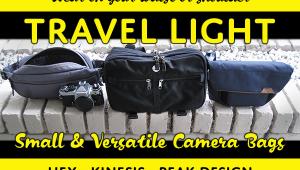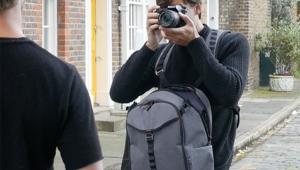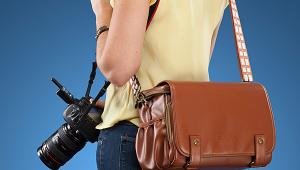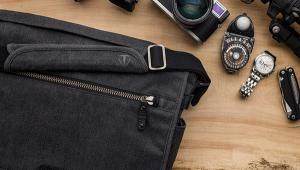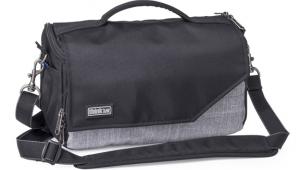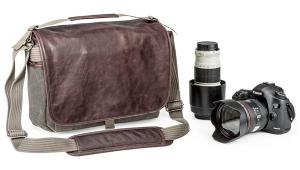Bags & Carrying Systems; Stow And Go
Let’s consider, to start, the humble camera strap. Several models of sling strap were shown, designed to carry the camera over your shoulder and under your arm or even on your hip. There were variations in mounting, support, and suitability for different purposes, but the one that really impressed us was the BlackRapid. Reluctantly, Frances allowed herself to be persuaded to try one on her Leica M8 on the first day of the show, and much to her surprise, found that she loved it and wore it for the rest of the show. One reason is that they have a model specifically shaped for women, with a curve in the strap so that it doesn’t cut into the tender bits, and another is that it has two locks to allow you to set limits to the travel of the camera loop on the strap itself. Set them close on either side, and the camera can’t slide at all; set the one at the back, but move the front one forward, and you can’t (easily) sit on the camera, the bane of many such designs. The ones for men are just as good.
There’s also a pouch version of the BlackRapid for compacts, and this highlights the disadvantage of any such strap: the camera is vulnerable. To counteract this, we just put OP/TECH’s Hood Hats on the lenses we were carrying at the show. These are neoprene “shower caps” that fit over the lenses and double as lens caps and camera protectors. Ours attracted enormous attention because they were custom-made with polka dots on them.
 |
|
|
Other over-the-shoulder straps came from Sun-Sniper and OP/TECH themselves. The former features a clever new patented swivel to fit into the camera tripod socket and a steel wire through the strap itself to impede the ungodly if they try to slash through it, a technique apparently much favored by scooter-riding bandits in Rome. This is a more sophisticated version of the old trick of sewing a steel guitar string to an existing strap. The OP/TECH version features their “weight reduction” neoprene straps and quick-release snap fasteners attaching to straps on the camera body: because they use the strap lugs, instead of the tripod socket, it’s very easy to put a pouch around the camera to protect it. All three systems are very good, but the only way to find the best one for you is to try it—which is a point worth reinforcing about ALL bags, straps, and the like, because what suits (or even fits) one person will not necessarily suit (or fit) another.
 |
|
|
Another camera carrying system, b-grip from Italy, looks at first like yet another of those waist-mount camera carriers which are either secure or quick-handling but rarely both, whereas in fact this one is both and incorporates a unique new feature which makes the camera vastly easier and more comfortable to carry: a sort of flap arrangement underneath that spreads the weight and means that you can even run while carrying the camera, without covering your leg in bruises.
 |
|
|
On the subject of security, a brilliant tiny accessory from OP/TECH was a packet of six little touch fastener strips called Secure-Its. These wrap around snap locks for extra security: something easier to illustrate than to describe. With top-quality American clips as used by OP/TECH you don’t need them, but anyone who has had a bad experience with cheap fasteners, especially the sort that falls open when you hit one side, will find these an invaluable reassurance.
 |
|
|
The kind of “one-shoulder backpack” pioneered by Lowepro’s SlingShot is ever more popular, and some models now offer the possibility of using either shoulder, though plenty are still designed to be used over the right shoulder only. They offer more and more protection with less and less weight—Frances was especially impressed by the Cullmann offering, imported by RTS—but they are an even stronger argument for the point made earlier: one size doesn’t fit all. The Think Tank Photo version was fine for Roger, but for Frances, it became surprisingly uncomfortable, surprisingly quickly, mostly because she is only 5 feet tall. The way in which the strap could be swapped from shoulder to shoulder was, however, extremely clever. M-ROCK’s prototype showed a lot of promise, too.
 |
|
|
Protection and light weight were points that were strongly emphasized by Kata, whose spokeswoman said, “We promise to make the lightest bags with the most protection. This will encourage competition, which is good, because everyone’s bags will then become lighter and more protective.” Kata’s background is in making military carrying equipment for the Israeli army. Instead of showing us specific bags, they showed some of the components, such as an ingenious bow spring for dissipating the energy of a knock, foam padding perforated with finger-sized holes for “added lightness” and better absorption of vibration, and cord zip-pull tags “because all those metal tags add a surprising amount of weight.”
 |
|
|
- Log in or register to post comments



